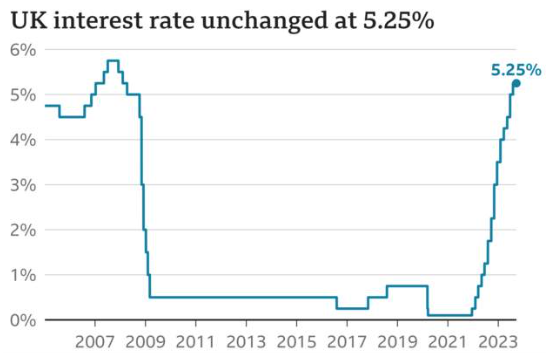Saturday, September 23rd, marked one year since the now infamous mini-budget delivered by Liz Truss and Kwasi Kwarteng. Many soon anticipated upheaval including within the property market as the base rate continued to climb and mortgage costs surge.
So where are we a year on?
According to the latest data from the Land Registry, property prices have only dipped by 0.75% from their peak a year ago. 
Remarkably, they remain 24.56% higher than the pre-Covid era. This resilience can be attributed, in part, to the persistent shortage of housing supply, which has failed to keep pace with the demand despite the effects of higher interest rates on buyers' purchasing power.
Last week marked a significant shift as the base rate remained unchanged for the first time since November 2021, following 14 consecutive increases as a number of prominent lenders have continued to nudge down their rates for a couple of months now with Nationwide, TSB, and, Natwest announcing further drops following the base rate announcement.
This newfound competition has led to a resurgence in fixed-rate deals. However, it's important to note that we're unlikely to return to the record-low sub-2% base rates seen from 2008 to 2021.
Homeowners should anticipate that their next mortgage deal will still be significantly more expensive than their previous one.
The Bank of England officials were divided on whether to raise rates again, with a narrow 5-4 majority voting for no change. Andrew Bailey has cautioned against expectations of rate decreases, indicating that they are likely to remain at 5.25% for now. As a result of previous increases, around 4.5 million families have experienced mortgage rate increases, with another 1.5 million expected to face rising rates by the end of 2024.
 While we are still dealing with a 15-year high for the base rate, it's essential to remember that the average over the past 50 years stands at 9.12%. This recent decision will come as a relief to prospective homebuyers who have already felt the impact of rising mortgage rates over the summer.
While we are still dealing with a 15-year high for the base rate, it's essential to remember that the average over the past 50 years stands at 9.12%. This recent decision will come as a relief to prospective homebuyers who have already felt the impact of rising mortgage rates over the summer.
So, what does all of this mean for the local property market?
Compared to last year, asking prices have dropped by 2%, and sales agreements have fallen by 20%.
Price changes have increased by 79%, and properties withdrawing from the market have risen by 77%.
Notably, 38% of properties were sold subject to contract within 30 days of first being advertised for sale in August 2023, down from 54% in August 2022.. For those who are struggling for a choice of properties to choose from, its interesting to see the number of properties for sale is now 71.5% higher than this time last year!These figures signal that we are no longer in the booming property market of 2021/2022, where properties sold quickly and at strong prices due to high demand.
To succeed in selling a property today, setting the right asking price from the beginning is crucial. Sellers who adjust their prices often end up selling for considerably less and taking a longer time to close deals or even withdrawing their properties from the market.
The uncertainty in the current market has prompted some potential property buyers and sellers to delay their decisions, a stark contrast to the years of stability and growth witnessed in the past.
To summarize, its been year transition economically, as the property market has faced challenges, but it has also demonstrated resilience. Changes in interest rates and inflation have influenced buyer behavior and property prices. Sellers must adapt to a changing landscape by pricing their properties correctly from the start, while buyers navigate a market that offers more choice but requires careful consideration.
To find how this has impacted you and your home find out today at Register for a FREE Property Valuation | McHugo Homes






Share this with
Email
Facebook
Messenger
Twitter
Pinterest
LinkedIn
Copy this link